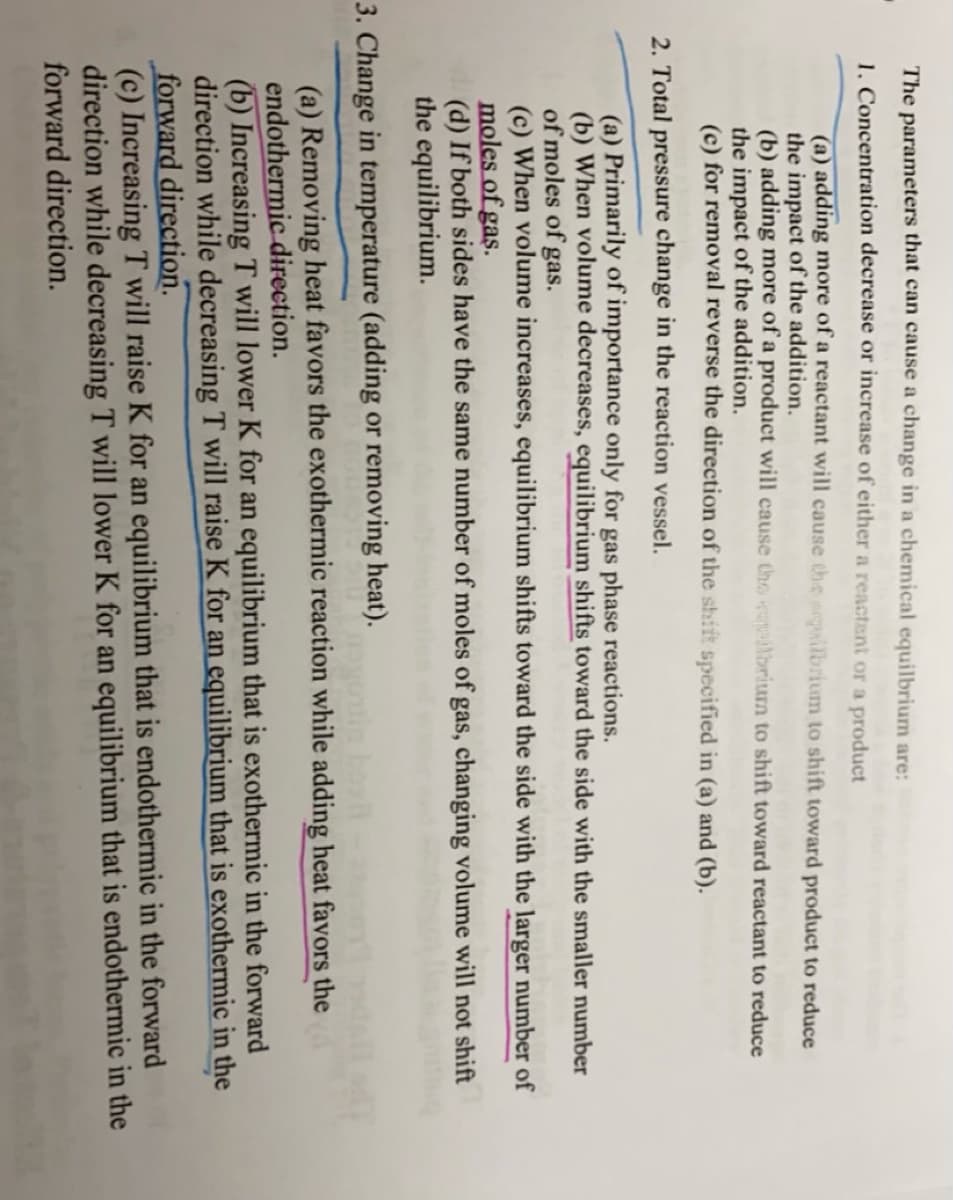The parameters that can cause a change in a chemical equilbrium are: 1. Concentration decrease or increase of either a reactant or a product (a) adding more of a reactant will cause the quilbrium to shift toward product to reduce the impact of the addition. (b) adding more of a product will cause the pailbriurn to shift toward reactant to reduce the impact of the addition. (c) for removal reverse the direction of the shift specified in (a) and (b). 2. Total pressure change in the reaction vessel. (a) Primarily of importance only for gas phase reactions. (b) When volume decreases, equilibrium shifts toward the side with the smaller number of moles of gas. (c) When volume increases, equilibrium shifts toward the side with the larger number of moles of gas. (d) If both sides have the same number of moles of gas, changing volume will not shift the equilibrium. 3. Change in temperature (adding or removing heat). (a) Removing heat favors the exothermic reaction while adding heat favors the endothermic direction. (b) Increasing T will lower K for an equilibrium that is exothermic in the forward direction while decreasing T will raise K for an equilibrium that is exothermic in the forward direction. (c) Increasing T will raise K for an equilibrium that is endothermic in the forward direction while decreasing T will lower K for an equilibrium that is endothermic in the forward direction.
The parameters that can cause a change in a chemical equilbrium are: 1. Concentration decrease or increase of either a reactant or a product (a) adding more of a reactant will cause the quilbrium to shift toward product to reduce the impact of the addition. (b) adding more of a product will cause the pailbriurn to shift toward reactant to reduce the impact of the addition. (c) for removal reverse the direction of the shift specified in (a) and (b). 2. Total pressure change in the reaction vessel. (a) Primarily of importance only for gas phase reactions. (b) When volume decreases, equilibrium shifts toward the side with the smaller number of moles of gas. (c) When volume increases, equilibrium shifts toward the side with the larger number of moles of gas. (d) If both sides have the same number of moles of gas, changing volume will not shift the equilibrium. 3. Change in temperature (adding or removing heat). (a) Removing heat favors the exothermic reaction while adding heat favors the endothermic direction. (b) Increasing T will lower K for an equilibrium that is exothermic in the forward direction while decreasing T will raise K for an equilibrium that is exothermic in the forward direction. (c) Increasing T will raise K for an equilibrium that is endothermic in the forward direction while decreasing T will lower K for an equilibrium that is endothermic in the forward direction.
Introductory Chemistry: A Foundation
9th Edition
ISBN:9781337399425
Author:Steven S. Zumdahl, Donald J. DeCoste
Publisher:Steven S. Zumdahl, Donald J. DeCoste
Chapter17: Equilibrium
Section: Chapter Questions
Problem 22QAP: . Suppose that for the reaction 2N2O(g)+O2(g)4NO((g))it is determined, at a particular temperature,...
Related questions
Question
See image below

Transcribed Image Text:The parameters that can cause a change in a chemical equilbrium are:
1. Concentration decrease or increase of either a reactant or a product
(a) adding more of a reactant will cause the quilbrium to shift toward product to reduce
the impact of the addition.
(b) adding more of a product will cause theilbrium to shift toward reactant to reduce
the impact of the addition.
(c) for removal reverse the direction of the shift specified in (a) and (b).
2. Total pressure change in the reaction vessel.
(a) Primarily of importance only for gas phase reactions.
(b) When volume decreases, equilibrium shifts toward the side with the smaller number
of moles of gas.
(c) When volume increases, equilibrium shifts toward the side with the larger number of
moles of gas.
(d) If both sides have the same number of moles of gas, changing volume will not shift
the equilibrium.
3. Change in temperature (adding or removing heat).
(a) Removing heat favors the exothermic reaction while adding heat favors the
endothermic direction.
(b) Increasing T will lower K for an equilibrium that is exothermic in the forward
direction while decreasing T will raise K for an equilibrium that is exothermic in the
forward direction.
(c) Increasing T will raise K for an equilibrium that is endothermic in the forward
direction while decreasing T will lower K for an equilibrium that is endothermic in the
forward direction.
Expert Solution
This question has been solved!
Explore an expertly crafted, step-by-step solution for a thorough understanding of key concepts.
Step by step
Solved in 2 steps

Knowledge Booster
Learn more about
Need a deep-dive on the concept behind this application? Look no further. Learn more about this topic, chemistry and related others by exploring similar questions and additional content below.Recommended textbooks for you

Introductory Chemistry: A Foundation
Chemistry
ISBN:
9781337399425
Author:
Steven S. Zumdahl, Donald J. DeCoste
Publisher:
Cengage Learning

Chemistry: Principles and Reactions
Chemistry
ISBN:
9781305079373
Author:
William L. Masterton, Cecile N. Hurley
Publisher:
Cengage Learning

Introductory Chemistry: An Active Learning Approa…
Chemistry
ISBN:
9781305079250
Author:
Mark S. Cracolice, Ed Peters
Publisher:
Cengage Learning

Introductory Chemistry: A Foundation
Chemistry
ISBN:
9781337399425
Author:
Steven S. Zumdahl, Donald J. DeCoste
Publisher:
Cengage Learning

Chemistry: Principles and Reactions
Chemistry
ISBN:
9781305079373
Author:
William L. Masterton, Cecile N. Hurley
Publisher:
Cengage Learning

Introductory Chemistry: An Active Learning Approa…
Chemistry
ISBN:
9781305079250
Author:
Mark S. Cracolice, Ed Peters
Publisher:
Cengage Learning


Chemistry for Today: General, Organic, and Bioche…
Chemistry
ISBN:
9781305960060
Author:
Spencer L. Seager, Michael R. Slabaugh, Maren S. Hansen
Publisher:
Cengage Learning
